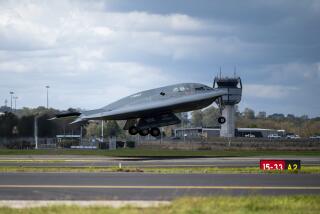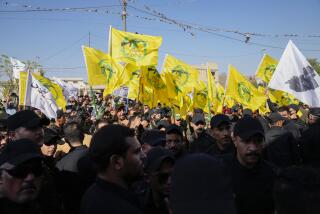U.S. Would Probably Use Missiles in Attack on Iraq
- Share via
WASHINGTON — A long-range attack by Tomahawk cruise missiles is likely to be the Pentagon’s first choice for punishing Iraq if diplomatic efforts and economic sanctions don’t quell Saddam Hussein’s defiance of U.N. weapons inspectors, military experts say.
Pentagon leaders appear to favor using as many as dozens of the $1.2-million sea-launched missiles to pound Iraq’s weapons factories, air defenses or other military assets, they say.
The U.S. military could also mobilize aircraft to add destructive power and accuracy to any response. But a large-scale attack by jet fighters is far less likely because of the U.S. leadership’s reluctance to have pilots injured--or seized as political trophies by the Iraqi president--the analysts say.
For the moment, U.S. and U.N. officials are downplaying the idea of using military force to persuade Hussein to allow U.S. weapons inspectors to resume their places on the U.N. arms control team overseeing the dismantling of Iraq’s weapons of mass destruction--and to withdraw his threat to shoot down a U.S. spy plane on loan to the U.N. disarmament team.
Instead, officials intend to try turning up the pressure through sanctions and continued diplomatic efforts. Tarik Aziz, Iraq’s deputy prime minister, is due in New York today and is expected to meet with U.N. Security Council members early in the week.
But U.S. and allied diplomats are losing patience, and prospects are rising that the confrontation might lead to a military strike.
The 18-foot-long Tomahawks, launched from Navy vessels and capable of traveling about 700 miles, have been used four times against Iraq since the end of the 1991 Persian Gulf War.
While they put no U.S. personnel at risk and deliver 1,000 pounds of explosive force, their power is limited. Twenty-four were needed to blow up the Iraqi military intelligence headquarters building in Baghdad in June 1993, and destruction of bigger military facilities is beyond their capacity, analysts say.
Because of that, and because of Hussein’s canniness in shifting targets, some military leaders and other experts have begun wondering about how effective such missile strikes would be in compelling Hussein to back down. “We’ve been blowing up a lot of things that Saddam doesn’t really care about,” one top military official said.
Targeting weapons factories would be a proportional response to Hussein’s latest actions, military experts say.
Still unclear is how much success the military would have in finding the weapons-building sites. While some outside analysts are skeptical, U.S. officials believe that they have a good fix on where the sites are and that Hussein could not move them in time to avoid damage.
The goal of any attack would also be psychological: U.S. policymakers want to convince Hussein that they can hurt him, either by destroying things that he cares about or by hitting his forces hard enough that they may begin to lose confidence in him, analysts say.
For those reasons, a military attack could include strikes against members of the Republican Guard, Hussein’s most loyal troops, who are mostly based around Baghdad.
Other targets could include the 200 to 300 planes in the Iraqi air force. These aircraft, which include MIG and Mirage jets, have usually been protected in concrete bunkers, and their destruction could shake the confidence of the air force pilots, a loyal group whose support is vital to Hussein, analysts say.
“They’d make a terrific target,” said Kenneth M. Pollack, an Iraq expert at the Washington Institute for Near East Policy.
But targeting those forces would be difficult. Hussein has dispersed his troops and his aircraft so well that dealing a serious blow would probably require a huge--and risky--air assault.
Also attractive are targets that might have personal meaning for Hussein: his home region of Tikrit, for example. But hitting any nonmilitary targets would risk “collateral damage”--loss of civilian lives--which the U.S. military does not want.
The Pentagon won’t expend much effort going after Hussein himself. In part because of anxieties about being safe from his own people, he changes location constantly, even when he is not fighting with the United Nations.
As to Hussein’s threat to shoot down the U-2 spy plane, which resumed flights today, the United States has left little doubt about how it will respond.
The spy plane flies at 60,000 feet, far above the reach of Iraqi fighter aircraft. Hussein does have antiaircraft missiles that pose a threat, although they are not very effective when fired that high--about twice the altitude of a commercial jet.
Regardless of their effectiveness, if Iraq did fire surface-to-air missiles, U.S. forces would no doubt respond immediately with missiles and jet fighters to try to destroy the weapons system involved, including any related radar or command-and-control centers.
(BEGIN TEXT OF INFOBOX / INFOGRAPHIC)
U.S. Forces in the Gulf
The United States maintains a force of more than 20,000 in the Persian Gulf region. It includes:
Navy
* 12,500 forces, including 5,500 aboard the aircraft carrier Nimitz
* Two crusiers
* Four destroyers
* Three guided missile frigates
* One attack submarine
Marines
* 2,100 combat-ready Marines in an amphibious force led by the assault ship Peleliu
* Assault helicopters
* Attack planes
Army
* About 1,500 soldiers in Kuwait
Air Force
* 120 fighters and other aircraft based mostly in Saudi Arabia. The contigent based at Prince Sultan Air Base in central Saudi Arabia includes about 6,000 combat and support personnel
Nimitz is carrying
* 5,500 crew members
* 77 aircraft
* 4.6 million pounds of air-launched missiles and bombs
Source: Associated Press
More to Read
Sign up for Essential California
The most important California stories and recommendations in your inbox every morning.
You may occasionally receive promotional content from the Los Angeles Times.











